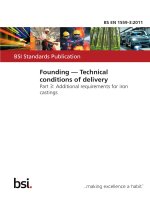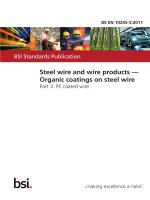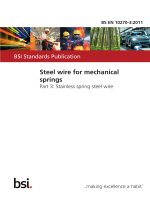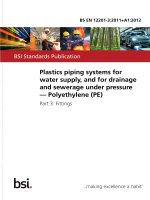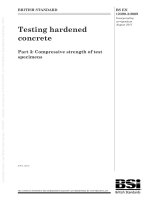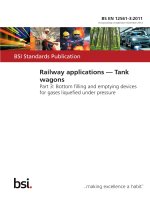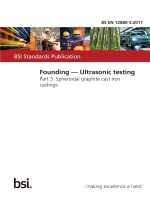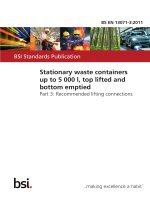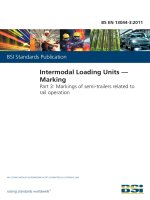Bsi bs en 62305 3 2011
Bạn đang xem bản rút gọn của tài liệu. Xem và tải ngay bản đầy đủ của tài liệu tại đây (6.01 MB, 162 trang )
BS EN 62305-3:2011
BSI Standards Publication
Protection against lightning
Part 3: Physical damage to structures and
life hazard
BS EN 62305-3:2011 BRITISH STANDARD
National foreword
This British Standard is the UK implementation of EN 62305-3:2011.
It was derived from IEC 62305-3:2010. It supersedes
BS EN 62305-3:2006, which will be withdrawn on 27 May 2012.
Parts 1, 3 and 4 of EN 62305 contain references to EN 62305-2:2011.
This reference is incorrect since Part 2 is not due to be published
until 2012 to allow for the finalization of the CENELEC common
modifications.
Until EN 62305-2:2012 is published and adopted as BS EN
62305-2:2012, the existing BS EN 62305-2:2006 can continue to be
used with the newly published BS EN 62305-1:2011, BS EN
62305-3:2011 and BS EN 62305-4:2011.
The CENELEC common modifications have been implemented at the
appropriate places in the text and are indicated by tags (e.g. }~).
The UK participation in its preparation was entrusted to Technical
Committee GEL/81, Protection against lightning.
A list of organizations represented on this committee can be obtained
on request to its secretary.
This publication does not purport to include all the necessary provisions
of a contract. Users are responsible for its correct application.
Compliance with a British Standard cannot confer immunity from
legal obligations.
ISBN 978 0 580 61195 7
ICS 29.020; 91.120.40
This British Standard was published under the authority of the Standards
Policy and Strategy Committee on 30 June 2011.
© BSI 2011
Amendments/corrigenda issued since publication
Date Text affected
EUROPEAN STANDARD EN 62305-3
NORME EUROPÉENNE
EUROPÄISCHE NORM March 2011
ICS 29.020; 91.120.40 Supersedes EN 62305-3:2006 + corr. Nov.2006 + corr. Sep.2008 + A11:2009
English version
Protection against lightning -
Part 3: Physical damage to structures and life hazard
(IEC 62305-3:2010, modified)
Protection contre la foudre - Blitzschutz -
Partie 3: Dommages physiques sur les Teil 3: Schutz von baulichen Anlagen und
structures et risques humains Personen
(CEI 62305-3:2010, modifiée) (IEC 62305-3:2010, modifiziert)
This European Standard was approved by CENELEC on 2011-01-02. CENELEC members are bound to comply
with the CEN/CENELEC Internal Regulations which stipulate the conditions for giving this European Standard
the status of a national standard without any alteration.
Up-to-date lists and bibliographical references concerning such national standards may be obtained on
application to the Central Secretariat or to any CENELEC member.
This European Standard exists in three official versions (English, French, German). A version in any other
language made by translation under the responsibility of a CENELEC member into its own language and notified
to the Central Secretariat has the same status as the official versions.
CENELEC members are the national electrotechnical committees of Austria, Belgium, Bulgaria, Croatia, Cyprus,
the Czech Republic, Denmark, Estonia, Finland, France, Germany, Greece, Hungary, Iceland, Ireland, Italy,
Latvia, Lithuania, Luxembourg, Malta, the Netherlands, Norway, Poland, Portugal, Romania, Slovakia, Slovenia,
Spain, Sweden, Switzerland and the United Kingdom.
CENELEC
European Committee for Electrotechnical Standardization
Comité Européen de Normalisation Electrotechnique
Europäisches Komitee für Elektrotechnische Normung
Management Centre: Avenue Marnix 17, B - 1000 Brussels
© 2011 CENELEC - All rights of exploitation in any form and by any means reserved worldwide for CENELEC members.
Ref. No. EN 62305-3:2011 E
BS EN 62305-3:2011 – 2 –
EN 62305-3:2011 (E)
Foreword
The text of the International Standard IEC 62305-3:2010, prepared by IEC TC 81, Lightning protection,
together with common modifications prepared by the Technical Committee CENELEC TC 81X, Lightning
protection, was submitted to the formal vote and was approved by CENELEC as EN 62305-3 on
2011-01-02.
This European Standard supersedes EN 62305-3:2006 + corr. Nov.2006 + corr. Sep.2008 + A11:2009.
This EN 62305-3:2011 includes the following significant technical changes with respect to
EN 62305-3:2006 + corr. Nov.2006 + corr. Sep.2008 + A11:2009:
1) Minimum thicknesses of metal sheets or metal pipes given in Table 3 for air-termination systems are
assumed as not able to prevent hot-spot problems.
2) Steel with electro-deposited copper is introduced as material suitable for LPS.
3) Some cross-sectional areas of LPS conductors were slightly modified.
4) For bonding purposes, isolating spark gaps are used for metal installations and SPD for internal
systems.
5) Two methods – simplified and detailed – are provided for evaluation of separation distance.
6) Protection measures against injuries of living beings due to electric shock are considered also inside
the structure.
7) Improved information for LPS in the case of structures with a risk of explosion are given in Annex D
(normative).
Attention is drawn to the possibility that some of the elements of this document may be the subject of
patent rights. CEN and CENELEC shall not be held responsible for identifying any or all such patent
rights.
The following dates were fixed:
– latest date by which the EN has to be implemented (dop) 2012-01-02
at national level by publication of an identical
national standard or by endorsement
– latest date by which the national standards conflicting (dow) 2014-01-02
with the EN have to be withdrawn
__________
Endorsement notice
The text of the International Standard IEC 62305-3:2010 was approved by CENELEC as a European
Standard with agreed common modifications as given below.
In the official version, for Bibliography, the following note has to be added for the standard indicated:
[2] IEC 61400-24 NOTE Harmonized as EN 61400-24.
– 3 – BS EN 62305-3:2011
EN 62305-3:2011 (E)
CONTENTS
FOREWORD ..................................................................................................................8
INTRODUCTION .......................................................................................................... 11
1 Scope.................................................................................................................... 12
2 Normative references.............................................................................................. 12
3 Terms and definitions.............................................................................................. 13
4 Lightning protection system (LPS) ............................................................................ 16
4.1 Class of LPS ................................................................................................. 16
4.2 Design of the LPS .......................................................................................... 17
4.3 Continuity of steelwork in reinforced concrete structures .................................... 17
5 External lightning protection system ......................................................................... 18
5.1 General......................................................................................................... 18
5.1.1 Application of an external LPS.............................................................. 18
5.1.2 Choice of external LPS ........................................................................ 18
5.1.3 Use of natural components................................................................... 18
5.2 Air-termination systems .................................................................................. 19
5.2.1 General .............................................................................................. 19
5.2.2 Positioning ......................................................................................... 19
5.2.3 Air-terminations against flashes to the side of tall structures.................... 20
5.2.4 Construction ....................................................................................... 21
5.2.5 Natural components ............................................................................ 21
5.3 Down-conductor systems ................................................................................ 22
5.3.1 General .............................................................................................. 22
5.3.2 Positioning for an isolated LPS ............................................................. 23
5.3.3 Positioning for a non-isolated LPS ........................................................ 23
5.3.4 Construction ....................................................................................... 24
5.3.5 Natural components ............................................................................ 24
5.3.6 Test joints .......................................................................................... 25
5.4 Earth-termination system ................................................................................ 25
5.4.1 General .............................................................................................. 25
5.4.2 Earthing arrangement in general conditions ........................................... 26
5.4.3 Installation of earth electrodes.............................................................. 27
5.4.4 Natural earth electrodes....................................................................... 28
5.5 Components .................................................................................................. 28
5.5.1 General .............................................................................................. 28
5.5.2 Fixing................................................................................................. 29
5.5.3 Connections ....................................................................................... 29
5.6 Materials and dimensions................................................................................ 30
5.6.1 Materials ............................................................................................ 30
5.6.2 Dimensions ........................................................................................ 30
6 Internal lightning protection system .......................................................................... 32
6.1 General......................................................................................................... 32
6.2 Lightning equipotential bonding ....................................................................... 33
6.2.1 General .............................................................................................. 33
6.2.2 Lightning equipotential bonding for metal installations............................. 33
6.2.3 Lightning equipotential bonding for external conductive parts................... 34
6.2.4 Lightning equipotential bonding for internal systems ............................... 35
BS EN 62305-3:2011 – 4 –
EN 62305-3:2011 (E)
6.2.5 Lightning equipotential bonding for lines connected to the structure to
be protected ....................................................................................... 35
6.3 Electrical insulation of the external LPS............................................................ 36
6.3.1 General .............................................................................................. 36
6.3.2 Simplified approach............................................................................. 37
6.3.3 Detailed approach ............................................................................... 37
7 Maintenance and inspection of an LPS ..................................................................... 38
7.1 General......................................................................................................... 38
7.2 Application of inspections ............................................................................... 38
7.3 Order of inspections ....................................................................................... 38
7.4 Maintenance.................................................................................................. 38
8 Protection measures against injury to living beings due to touch and step voltages ....... 38
8.1 Protection measures against touch voltages ..................................................... 38
8.2 Protection measures against step voltages ....................................................... 39
Annex A (normative) Positioning the air-termination system ............................................. 40
Annex B (normative) Minimum cross-section of the entering cable screen in order to
avoid dangerous sparking.............................................................................................. 46
Annex C (informative) Evaluation of the separation distance s.......................................... 47
Annex D (normative) Additional information for LPS in the case of structures with a
risk of explosion ........................................................................................................... 53
Annex E (informative) Guidelines for the design, construction, maintenance and
inspection of lightning protection systems ....................................................................... 60
Bibliography............................................................................................................... 157
Figure 1 – Protection angle corresponding to the class of LPS .......................................... 20
Figure 2 – Loop in a down-conductor .............................................................................. 24
Figure 3 – Minimum length l1 of each earth electrode according to the class of LPS ............ 26
Figure A.1 – Volume protected by a vertical air-termination rod ......................................... 40
Figure A.2 – Volume protected by a vertical air-termination rod ......................................... 41
Figure A.3 – Volume protected by a wire air-termination system ........................................ 41
Figure A.4 – Volume protected by isolated wires combined in a mesh according to the
protection angle method and rolling sphere method ......................................................... 42
Figure A.5 – Volume protected by non-isolated wires combined in a mesh according to
the mesh method and the protection angle method .......................................................... 43
Figure A.6 – Design of an air-termination system according to the rolling sphere
method ........................................................................................................................ 44
Figure C.1 – Values of coefficient kc in the case of a wire air-termination system ................ 47
Figure C.2 – Values of coefficient kc in the case of multiple down-conductors system .......... 48
Figure C.3 – Values of coefficient kc in the case of a sloped roof with air-termination on
the ridge ...................................................................................................................... 50
Figure C.4 – Examples of calculation of the separation distance in the case of multiple
down-conductors with an interconnecting ring of the down-conductors at each level ............ 51
Figure C.5 – Values of coefficient kc in the case of a meshed air-termination system,
with a multiple down-conductors system ......................................................................... 52
Figure E.1 – LPS design flow diagram ............................................................................ 62
Figure E.2 – LPS design for a cantilevered part of a structure ........................................... 68
Figure E.3 – Measuring the overall electrical resistance ................................................... 69
– 5 – BS EN 62305-3:2011
EN 62305-3:2011 (E)
Figure E.4 – Equipotential bonding in a structure with a steel reinforcement ....................... 71
Figure E.5 – Typical methods of joining reinforcing rods in concrete (where permitted) ........ 72
Figure E.6 – Example of clamps used as joints between reinforcing rods and
conductors................................................................................................................... 73
Figure E.7 – Examples for connection points to the reinforcement in a reinforced
concrete wall................................................................................................................ 74
Figure E.8 – Use of metallic facade as natural down-conductor system and connection
of facade supports ........................................................................................................ 78
Figure E.9 – Connection of the continuous strip windows to a metal facade covering........... 79
Figure E.10 – Internal down-conductors in industrial structures ......................................... 82
Figure E.11 – Installation of bonding conductors in reinforced concrete structures and
flexible bonds between two reinforced concrete parts....................................................... 84
Figure E.12 – Protection angle method air-termination design for different heights
according to Table 2 ..................................................................................................... 88
Figure E.13 – Isolated external LPS using two isolated air-termination masts designed
according to the protection angle air-termination design method........................................ 89
Figure E.14 – Isolated external LPS using two isolated air-termination masts,
interconnected by horizontal catenary wire...................................................................... 90
Figure E.15 – Example of design of an air-termination of a non-isolated LPS by air-
termination rods ........................................................................................................... 91
Figure E.16 – Example of design of an air-termination of a non isolated LPS by a
horizontal wire according to the protection angle air-termination design method.................. 92
Figure E.17 – Protected volume of an air- termination rod on a sloped surface using
the protection angle design method ................................................................................ 93
Figure E.18 – Design of an LPS air-termination conductor network on a structure with
complicated shape........................................................................................................ 94
Figure E.19 – Design of an LPS air-termination according to the protection angle
method, mesh method and general arrangement of air-termination elements ..................... 95
Figure E.20 – Space protected by two parallel air-termination horizontal wires or two
air-termination rods (r > ht) ............................................................................................ 96
Figure E.21 – Three examples of design of non-isolated LPS air-termination according
to the mesh method air-termination design ...................................................................... 99
Figure E.22 – Four examples of details of an LPS on a structure with sloped tiled roofs..... 101
Figure E.23 – Air-termination and visually concealed conductors for buildings less
than 20 m high, with sloping roofs ................................................................................ 102
Figure E.24 – Construction of an LPS using natural components on the roof of the
structure.................................................................................................................... 104
Figure E.25 – Positioning of the external LPS on a structure made of isolating material
e.g. wood or bricks with a height up to 60 m with flat roof and with roof fixtures ................ 105
Figure E.26 – Construction of air-termination network on a roof with conductive
covering where puncturing of the covering is not acceptable ........................................... 106
Figure E.27 – Construction of external LPS on a structure of steel-reinforced concrete
using the reinforcement of the outer walls as natural components ................................... 107
Figure E.28 – Example of an air-termination stud used on car park roofs.......................... 108
Figure E.29 – Air-termination rod used for protection of a metallic roof fixture with
electric power installations which are not bonded to the air-termination system................. 109
Figure E.30 – Method of achieving electrical continuity on metallic parapet capping .......... 110
Figure E.31 – Metallic roof fixture protected against direct lightning interception,
connected to air-termination system ............................................................................. 113
BS EN 62305-3:2011 – 6 –
EN 62305-3:2011 (E)
Figure E.32 – Examplesof lightning protection of a house with a TV antenna .................... 116
Figure E.33 – Installation of lightning protection of metallic equipment on a roof against
a direct lightning flash ................................................................................................. 117
Figure E.34 – Connection of natural air-termination rod to air-termination conductor ......... 119
Figure E.35 – Construction of the bridging between the segments of the metallic
facade plates ............................................................................................................. 120
Figure E.36 – Installation of external LPS on a structure of insulating material with
different roof levels..................................................................................................... 123
Figure E.37 – Five examples of geometry of LPS conductors .......................................... 124
Figure E.38 – Construction of an LPS using only two down-conductors and foundation
earth electrodes ......................................................................................................... 125
Figure E.39 – Four examples of connection of earth-termination to the LPS of
structures using natural down-conductors (girders) and detail of a test joint...................... 129
Figure E.40 – Construction of foundation earth ring for structures of different
foundation design ....................................................................................................... 133
Figure E.41 – Two examples of vertical electrodes in type A earthing arrangement ........... 135
Figure E.42 – Meshed earth-termination system of a plant .............................................. 138
Figure E.43 – Example of an equipotential bonding arrangement..................................... 145
Figure E.44 – Example of bonding arrangement in a structure with multiple point
entries of external conductive parts using a ring electrode for interconnection of
bonding bars.............................................................................................................. 146
Figure E.45 – Example of bonding in the case of multiple point entries of external
conductive parts and an electric power or communication line using an internal ring
conductor for interconnection of the bonding bars .......................................................... 147
Figure E.46 – Example of bonding arrangement in a structure with multiple point
entries of external conductive parts entering the structure above ground level .................. 148
Figure E.47 – Directions for calculations of the separation distance, s, for a worst case
lightning interception point at a distance l from the reference point according to 6.3 .......... 150
Table 1 – Relation between lightning protection levels (LPL) and class of LPS (see
EN 62305-1) ............................................................................................................... 17
Table 2 – Maximum values of rolling sphere radius, mesh size and protection angle
corresponding to the class of LPS .................................................................................. 20
Table 3 – Minimum thickness of metal sheets or metal pipes in air-termination systems....... 22
Table 4 – Typical preferred values of the distance between down-conductors
according to the class of LPS ........................................................................................ 23
Table 5 – LPS materials and conditions of use ................................................................ 29
Table 6 – Material, configuration and minimum cross-sectional area of air-termination
conductors, air-termination rods, earth lead-in rods and down-conductors .......................... 31
Table 7 – Material, configuration and minimum dimensions of earth electrodes ................... 32
Table 8 – Minimum dimensions of conductors connecting different bonding bars or
connecting bonding bars to the earth-termination system.................................................. 34
Table 9 – Minimum dimensions of conductors connecting internal metal installations to
the bonding bar ............................................................................................................ 34
Table 10 – Isolation of external LPS – Values of coefficient ki ........................................... 36
Table 11 – Isolation of external LPS – Values of coefficient km.......................................... 36
Table 12 – Isolation of external LPS – Approximated values of coefficient kc ...................... 37
Table B.1 – Cable length to be considered according to the condition of the screen ............ 46
Table E.1 – Suggested fixing centres............................................................................ 100
– 7 – BS EN 62305-3:2011
EN 62305-3:2011 (E)
Table E.2 – Maximum period between inspections of an LPS .......................................... 152
BS EN 62305-3:2011 – 8 –
EN 62305-3:2011 (E)
INTERNATIONAL ELECTROTECHNICAL COMMISSION
_____________
PROTECTION AGAINST LIGHTNING –
Part 3: Physical damage to structures and life hazard
F O REW ORD
1) The International Electrotechnical Commission (IEC) is a worldwide organization for standardization c omprising
all national electrotechnical committees (IEC National Committees). The object of IEC is to promote
international co-operation on all questions concerning standardization in the electrical and electronic fields. To
this end and in addition to other activities, IEC publishes International Standards, Technical Specifications,
Technical Reports, Publicly Available Specifications (PAS) and Guides (hereafter referred to as “IEC
Publication(s)”). Their preparation is entrusted to technical committees; any IEC National Committee interested
in the subject dealt with may participate in this preparatory work. International, governmental and non-
governmental organizations liaising with the IEC also participate in this preparation. IEC collaborates closely
with the International Organization for Standardization (ISO) in accordance with conditions determined by
agreement between the two organizations.
2) The formal decisions or agreements of IEC on technical matters express, as nearly as possible, an international
consensus of opinion on the relevant subjects since each technical committee has representation from all
interested IEC National Committees.
3) IEC Publications have the form of recommendations for international use and are accepted by IEC National
Committees in that sense. W hile all reasonable efforts are made to ensure that the technical content of IEC
Publications is accurate, IEC cannot be held responsible for the way in which they are used or for any
misinterpretation by any end user.
4) In order to promote international uniformity, IEC National Committees undertake to apply IEC Publications
transparently to the maximum extent possible in their national and regional publications. Any divergenc e
between any IEC Publication and the corresponding national or regional publication shall be clearly indicated in
the latter.
5) IEC itself does not provide any attestation of conformity. Independent certification bodies provide conformit y
assessment services and, in some areas, access to IEC marks of conformity. IEC is not responsible for any
services carried out by independent certification bodies.
6) All users should ensure that they have the latest edition of this publication.
7) No liability shall attach to IEC or its directors, employees, servants or agents including individual experts and
members of its technical committees and IEC National Committees for any personal injury, property damage or
other damage of any nature whatsoever, whether direct or indirect, or for costs (including legal fees) and
expenses arising out of the publication, use of, or reliance upon, this IEC Publication or any other IEC
Publications.
8) Attention is drawn to the Normative references cited in this publication. Use of the referenced publications is
indispensable for the correct application of this publication.
9) Attention is drawn to the possibility that some of the elements of this IEC Publication may be the subject of
patent rights. IEC shall not be held responsible for identifying any or all such patent rights.
International Standard }EN 62305-3~ has been prepared by IEC technical committee 81:
Lightning protection.
This second edition cancels and replaces the first edition, published in 2006, and constitutes
a technical revision.
This edition includes the following significant technical changes with respect to the previous
edition:
1) Minimum thicknesses of metal sheets or metal pipes given in Table 3 for air-termination
systems are assumed as not able to prevent hot-spot problems.
2) Steel with electro-deposited copper is introduced as material suitable for LPS.
3) Some cross-sectional areas of LPS conductors were slightly modified.
4) For bonding purposes, isolating spark gaps are used for metal installations and SPD for
internal systems.
– 9 – BS EN 62305-3:2011
EN 62305-3:2011 (E)
5) Two methods – simplified and detailed – are provided for evaluation of separation
distance.
6) Protection measures against injuries of living beings due to electric shock are considered
also inside the structure.
7) Improved information for LPS in the case of structures with a risk of explosion are given in
Annex D (normative).
The text of this standard is based on the following documents:
FDIS Report on voting
81/372/FDIS 81/382/RVD
Full information on the voting for the approval of this standard can be found in the report on
voting indicated in the above table.
This publication has been drafted, as closely as possible, in accordance with the ISO/IEC
Directives, Part 2.
A list of all the parts in the}EN 62305~ series, under the general title Protection against
lightning, can be found on the IEC website.
BS EN 62305-3:2011 – 10 –
EN 62305-3:2011 (E)
The committee has decided that the contents of this publication will remain unchanged until
the stability date indicated on the IEC web site under "" in the data
related to the specific publication. At this date, the publication will be
• reconfirmed,
• withdrawn,
• replaced by a revised edition, or
• amended.
In the United States, based on the requirements of NFPA 780: Standard for the Installation of Lightning Protection
Systems:2008 [1] 1 and practical experience in the use of horizontal earth electrodes, the minimum length of
horizontal earth electrodes is not required to be twice that required for vertical electrodes.
In France and Portugal:
– natural components cannot substitute as lightning protection components but may be used to
complete/enhance the LPS;
– aluminium solid round diameters should be increased from 8 mm to 10 mm;
– stranded conductors cannot be used as down-conductors;
– diameter of solid round conductors should be increased from 16 mm to 18 mm;
– hot dip galvanized steel solid tape thickness should be increased from 2 mm to 3,5 mm.
In Russia the use of piping carrying and tanks containing readily-c ombustible or explosive materials as air-
termination natural components or down-conductor natural components are not allowed in any case.
In Japan the minimum values of the cross-section are reduced from:
– 16 mm2 to 14 mm2 for copper and 25 mm2 to 22 mm2 for aluminium, for bonding conductors connecting
different bonding bars and conductors connecting the bars to the earth-termination system;
– 6 mm2 to 5 mm2 for copper, 10 mm2 to 8 mm2 for aluminium and 16 mm2 to 14 mm2 for steel, for bonding
conductors connecting internal metal installations to the bonding bars.
A bilingual version of this publication may be issued at a later date.
IMPORTANT – The 'colour inside' logo on the cover page of this publication indicates
that it contains colours which are considered to be useful for the correct
understanding of its contents. Users should therefore print this document using a
colour printer.
———————
1 References in square brackets refer to the bibliography.
– 11 – BS EN 62305-3:2011
EN 62305-3:2011 (E)
INTRODUCTION
This part of }EN 62305~ deals with the protection, in and around a structure, against physical
damage and injury to living beings due to touch and step voltages.
The main and most effective measure for protection of structures against physical damage is
considered to be the lightning protection system (LPS). It usually consists of both external
and internal lightning protection systems.
An external LPS is intended to
a) intercept a lightning flash to the structure (with an air-termination system),
b) conduct the lightning current safely towards earth (using a down-conductor system),
c) disperse the lightning current into the earth (using an earth-termination system).
An internal LPS prevents dangerous sparking within the structure using either equipotential
bonding or a separation distance (and hence electrical insulation) between the external LPS
(as defined in 3.2) components and other electrically conducting elements internal to the
structure.
Main protection measures against injury to living beings due to touch and step voltages are
intended to:
1) reduce the dangerous current flowing through bodies by insulating exposed conductive
parts, and/or by increasing the surface soil resistivity,
2) reduce the occurrence of dangerous touch and step voltages by physical restrictions
and/or warning notices.
The type and location of an LPS should be carefully considered in the initial design of a new
structure, thereby enabling maximum advantage to be taken of the electrically conductive
parts of the structure. By doing so, design and construction of an integrated installation is
made easier, the overall aesthetic aspects can be improved, and the effectiveness of the LPS
can be increased at minimum cost and effort.
Access to the ground and the proper use of foundation steelwork for the purpose of forming
an effective earth-termination may well be impossible once construction work on a site has
commenced. Therefore, soil resistivity and the nature of the earth should be considered at the
earliest possible stage of a project. This information is fundamental to the design of an earth-
termination system and may influence the foundation design work for the structure.
Regular consultation between LPS designers and installers, architects and builders is
essential in order to achieve the best result at minimum cost.
If lightning protection is to be added to an existing structure, every effort should be made to
ensure that it conforms to the principles of this standard. The design of the type and location
of an LPS should take into account the features of the existing structure.
BS EN 62305-3:2011 – 12 –
EN 62305-3:2011 (E)
PROTECTION AGAINST LIGHTNING –
Part 3: Physical damage to structures and life hazard
1 Scope
This part of }EN 62305~ provides the requirements for protection of a structure against physical
damage by means of a lightning protection system (LPS), and for protection against injury to
living beings due to touch and step voltages in the vicinity of an LPS (see }EN 62305 -1~).
This standard is applicable to:
a) design, installation, inspection and maintenance of an LPS for structures without limitation
of their height,
b) establishment of measures for protection against injury to living beings due to touch and
step voltages.
NOTE 1 Specific requirements for an LPS in structures dangerous to their surroundings due to the risk of explosion ar e
under consideration. Additional inf ormation is provided in Annex D for us e in the interim.
NOTE 2 This part of }EN 62305~ is not intended to provide protection against failures of electrical and electronic
systems due to overvoltages. Specific requirements for such cas es are provided in }EN 62305-4~.
NOTE 3 Specific requirements for protection against lightning of wind turbines are reported in IEC 61400-24 [2].
2 Normative references
}The following referenced documents are indispensable for the application of this document. For dated
references, only the edition cited applies. For undated references, the latest edition of the referenced
document (including any amendments) applies.
EN 50164-1 Lightning Protection Components (LPC) – Part 1: Requirements for connection
EN 50164-2 components
EN 50164-3
EN 50164-4 Lightning Protection Components (LPC) – Part 2: Requirements for conductors
EN 50164-5 and earth electrodes
EN 50164-6
EN 50164-7 Lightning Protection Components (LPC) – Part 3: Requirements for isolating
spark gaps
Lightning Protection Components (LPC) – Part 4: Requirements for conductor
fasteners
Lightning Protection Components (LPC) – Part 5: Requirements for earth
electrode inspection housings and earth electrode seals
Lightning Protection Components (LPC) – Part 6: Requirements for lightning
strike counters
Lightning Protection Components (LPC) – Part 7: Requirements for earthing
enhancing compounds
NOTE The above mentioned standards EN 50164 series will ultimately be replaced by EN 62561 series. EN 50164 series will still
be valid for 72 months from the issuing date of each part of the EN 50164 series.
EN 60079-10-1:2009 Explosive atmospheres – Part 10-1: Classification of areas – Explosive gas
EN 60079-10-2:2009 atmospheres (IEC 60079-10-1:2008)
EN 60079-14:2008
EN 61557-4 Explosive atmospheres – Part 10-2: Classification of areas – Combustible dust
atmospheres (IEC 60079-10-2:2009)
Explosive atmospheres – Part 14: Electrical installations design, selection and
erection (IEC 60079-14:2007)
Electrical safety in low voltage distribution systems up to 1 000 V a.c. and
1 500 V d.c. – Equipment for testing, measuring or monitoring of protective
measures – Part 4: Resistance of earth connection and equipotential bonding
(IEC 61557-4)~
– 13 – BS EN 62305-3:2011
EN 62305-3:2011 (E)
}EN 61643-11 Low-voltage surge protective devices – Part 1: Surge protective devices
connected to low-voltage power distribution systems – Requirements and tests
EN 61643-21 (IEC 61643-1)
EN 62305-1:2011 Low voltage surge protective devices – Part 21: Surge protective devices
EN 62305-2:2011 connected to telecommunications and signalling networks – Performance
EN 62305-4:2011 requirements and testing methods (IEC 61643-21)
EN 62561 series 1)
EN 62561-1 2) Protection against lightning – Part 1: General principles (IEC 62305-1:2010,
EN 62561-3 2) modified)
ISO 3864-1
Protection against lightning – Part 2: Risk management (IEC 62305-2:2010,
modified)
Protection against lightning – Part 4: Electrical and electronic systems within
structures (IEC 62305-4:2010, modified)
Lightning Protection System Components (LPSC) (IEC 62561 series)
Lightning Protection System Components (LPSC) – Part 1: Requirements for
connection components (IEC 62561)
Lightning Protection System Components (LPSC) – Part 3: Requirements for
isolating spark gaps (IEC 62561-3)
Graphical symbols – Safety colours and safety signs – Part 1: Design principles
for safety signs in workplaces and public areas~
3 Terms and definitions
For the purposes of this document, the following terms and definitions, some of which have
already been cited in Part 1 but are repeated here for ease of reference, as well as those
given in other parts of }EN 62305~, apply.
3.1
lightning protection system
LPS
complete system used to reduce physical damage due to lightning flashes to a structure
NOTE It consists of both external and internal lightning protection systems.
3.2
external lightning protection system
part of the LPS consisting of an air-termination system, a down-conductor system and an
earth-termination system
3.3
external LPS isolated from the structure to be protected
LPS with an air-termination system and down-conductor system positioned in such a way that
the path of the lightning current has no contact with the structure to be protected
NOTE In an isolated LPS, dangerous sparks between the LPS and the structure are avoided.
3.4
external LPS not isolated from the structure to be protected
LPS with an air-termination system and down-conductor system positioned in such a way that
the path of the lightning current can be in contact with the structure to be protected
3.5
internal lightning protection system
part of the LPS consisting of lightning equipotential bonding and/or electrical insulation of
external LPS
3.6
air-termination system
part of an external LPS using metallic elements such as rods, mesh conductors or catenary
wires intended to intercept lightning flashes
———————
1) In preparation.
2) At draft stage.
BS EN 62305-3:2011 – 14 –
EN 62305-3:2011 (E)
3.7
down-conductor system
part of an external LPS intended to conduct lightning current between the air-termination
system and the earth-termination system
3.8
ring conductor
conductor forming a loop around the structure and interconnecting the down-conductors for
distribution of lightning current among them
3.9
earth-termination system
part of an external LPS which is intended to conduct and disperse lightning current into the
earth
3.10
earth electrode
part or a group of parts of the earth-termination system which provides direct electrical
contact with the earth and disperses lightning current to the earth
3.11
ring earth electrode
earth electrode forming a closed loop around the structure below or on the surface of the
earth
3.12
foundation earth electrode
conductive part buried in the soil under a building foundation or, preferably, embedded in
concrete of a building foundation, generally in form of a closed loop
[IEC 60050-826:2004, 826-13-08] [3]
3.13
conventional earth impedance
ratio of the peak values of the earth-termination voltage and the earth-termination current
which, in general, do not occur simultaneously
3.14
earth-termination voltage
potential difference between the earth-termination system and the remote earth
3.15
natural component of LPS
conductive component installed not specifically for lightning protection which can be used in
addition to the LPS or in some cases could provide the function of one or more parts of the
LPS
NOTE Examples of the use of this term include:
– natural air-termination;
– natural down-conductor;
– natural earth electrode.
3.16
connecting component
part of an LPS which is used for the connection of conductors to each other or to metallic
installations}as defined in the EN 50164 series~
NOTE This also includes bridging component and expansion piece.
– 15 – BS EN 62305-3:2011
EN 62305-3:2011 (E)
3.17
fixing component
part of an LPS which is used to fix the elements of the LPS to the structure to be protected
}as defined in the EN 50164 series~
3.18
metal installations
extended metal items in the structure to be protected which may form a path for lightning
current, such as pipework, staircases, elevator guide rails, ventilation, heating and air-
conditioning ducts, interconnected reinforcing steel, structural metal parts
3.19
external conductive parts
extended metal items entering or leaving the structure to be protected such as pipework,
metallic cable elements, metal ducts, etc. which may carry a part of the lightning current
3.20
electrical system
system incorporating low-voltage power supply components
3.21
electronic system
system incorporating sensitive electronic components such as telecommunication equipment,
computer, control and instrumentation systems, radio systems, power electronic installations
3.22
internal systems
electrical and electronic systems within a structure
3.23
lightning equipotential bonding
EB
bonding to the LPS of separated conductive parts, by direct connections or via surge
protective devices, to reduce potential differences caused by lightning current
3.24
bonding bar
metal bar on which metal installations, external conductive parts, electric power and tele-
communication lines and other cables can be bonded to an LPS
3.25
bonding conductor
conductor connecting separated conductive parts to LPS
3.26
interconnected reinforcing steel
steelwork within a concrete structure which is considered electrically continuous
3.27
dangerous sparking
electrical discharge due to lightning which causes physical damage in the structure to be
protected
3.28
separation distance
distance between two conductive parts at which no dangerous sparking can occur
BS EN 62305-3:2011 – 16 –
EN 62305-3:2011 (E)
3.29
surge protective device
SPD
device intended to limit transient overvoltages and divert surge currents; contains at least one
non linear component
3.30
test joint
joint designed to facilitate electrical testing and measurement of LPS components
3.31
class of LPS
number denoting the classification of an LPS according to the lightning protection level for
which it is designed
3.32
lightning protection designer
specialist competent and skilled in the design of the LPS
3.33
lightning protection installer
person competent and skilled in the installation of the LPS
3.34
structures with risk of explosion
structures containing solid explosives materials or hazardous zones as determined in
accordance with IEC 60079-10-1 and IEC 60079-10-2
3.35
isolating spark gap
ISG
component with discharge distance for isolating electrically conductive installation sections
NOTE In the event of a lightning strike, the installation sections are temporarily connected conductively as the
result of response to the discharge.
3.36
isolating interfaces
devices which are capable of reducing conducted surges on lines entering the LPZ
NOTE 1 These include isolation transformers with earthed screen between windings, metal-free fibre optic cables
and opto-isolators.
NOTE 2 Insulation withstand characteristics of these devices are suitable for this application intrinsically or vi a
SPD.
4 Lightning protection system (LPS)
4.1 Class of LPS
The characteristics of an LPS are determined by the characteristics of the structure to be
protected and by the considered lightning protection level.
Four classes of LPS (I to IV), as shown in Table 1, are defined in this standard corresponding
to lightning protection levels defined in }EN 62305-1~ .
– 17 – BS EN 62305-3:2011
EN 62305-3:2011 (E)
Table 1 – Relation between lightning protection levels (LPL)
and class of LPS (see}EN 62305-1~)
LPL Class of LPS
I I
II II
III III
IV IV
Each class of LPS is characterized by the following:
a) Data dependent upon the class of LPS:
– lightning parameters (see Tables 3 and 4 in }EN 62305 -1:2010~);
– rolling sphere radius, mesh size and protection angle (see 5.2.2);
– typical preferred distances between down-conductors (see 5.3.3);
– separation distance against dangerous sparking (see 6.3);
– minimum length of earth electrodes (see 5.4.2).
b) Factors not dependent upon the class of LPS:
– lightning equipotential bonding (see 6.2);
– minimum thickness of metal sheets or metal pipes in air-termination systems
(see 5.2.5);
– LPS materials and conditions of use (see 5.5.1);
– material, configuration and minimum dimensions for air-terminations, down-conductors
and earth-terminations (see 5.6);
– minimum dimensions of connecting conductors (see 6.2.2).
Performance of each class of LPS is given in Annex B of }EN 62305-2:2010~.
The class of required LPS shall be selected on the basis of a risk assessment (see
}EN 62305-2~).
4.2 Design of the LPS
A technically and economically optimized design of an LPS is possible, especially if the steps
in the design and construction of the LPS are coordinated with the steps in the design and
construction of the structure to be protected. In particular, the design of the structure itself
should utilize the metal parts of the structure as parts of the LPS.
The design of the class and location of the LPS for existing structures shall take into account
the constraints of the existing situation.
The design documentation of an LPS shall contain all the information necessary to ensure
correct and complete installation. For detailed information, see Annex E.
The LPS should be designed and installed by well-trained and expert LPS designers and
installers (see E.4.2)
4.3 Continuity of steelwork in reinforced concrete structures
Steelwork within reinforced concrete structures is considered to be electrically continuous
provided that the major part of interconnections of vertical and horizontal bars are welded or
otherwise securely connected. Connections of vertical bars shall be welded, clamped or
overlapped a minimum of 20 times their diameters and bound or otherwise securely
connected (see Figure E.5). For new structures, the connections between reinforcement
BS EN 62305-3:2011 – 18 –
EN 62305-3:2011 (E)
elements shall be specified by the designer or installer, in cooperation with the builder and the
civil engineer.
For structures utilizing steel-reinforced concrete (including pre-cast, pre-stressed reinforced
units), the electrical continuity of the reinforcing bars shall be determined by electrical testing
between the uppermost part and ground level. The overall electrical resistance should not be
greater than 0,2 :, measured using test equipment suitable for this purpose. If this value is
not achieved, or it is not practical to conduct such testing, the reinforcing steel shall not be
used as a natural down-conductor as discussed in 5.3.5. In this case it is recommended that
an external down-conductor system be installed. In the case of structures of pre-cast
reinforced concrete, the electrical continuity of the reinforcing steel shall be established
between individual adjacent pre-cast concrete units.
NOTE 1 For further information on the continuity of steelwork in reinforc ed concrete structures, see Annex E.
}NOTE 2 When the continuity of steelwork in reinforced concrete is intended to be established by clamping, specifically designed
clamps complying with and tested according to EN 50164-1, should be used.~
NOTE 3 Clamps to establish the continuity of steelwork in reinforced concrete should comply with the future
}EN 62561-1.~
5 External lightning protection system
5.1 General
5.1.1 Application of an external LPS
The external LPS is intended to intercept direct lightning flashes to the structure, including
flashes to the side of the structure, and conduct the lightning current from the point of strike to
ground. The external LPS is also intended to disperse this current into the earth without
causing thermal or mechanical damage, or dangerous sparking which may trigger fire or
ex pl o si o n s.
5.1.2 Choice of external LPS
In most cases, the external LPS may be attached to the structure to be protected.
An isolated external LPS should be considered when the thermal and explosive effects at the
point of strike, or on the conductors carrying the lightning current, may cause damage to the
structure or to the contents (see Annex E). Typical examples include structures with
combustible covering, structures with combustible walls and areas at risk of explosion and
fire.
NOTE The use of an isolated LPS may be convenient where it is predicted that changes in the structure, its
contents or its use will require modifications to the LPS.
An isolated external LPS may also be considered when the susceptibility of the contents
warrants the reduction of the radiated electromagnetic field associated with the lightning
current pulse in the down-conductor.
5.1.3 Use of natural components
Natural components made of conductive materials, which will always remain in/on the
structure and will not be modified (e.g. interconnected steel-reinforcement, metal framework
of the structure, etc.) may be used as parts of an LPS.
Other natural components can only be considered as being additional to an LPS.
NOTE For further information, see Annex E.
